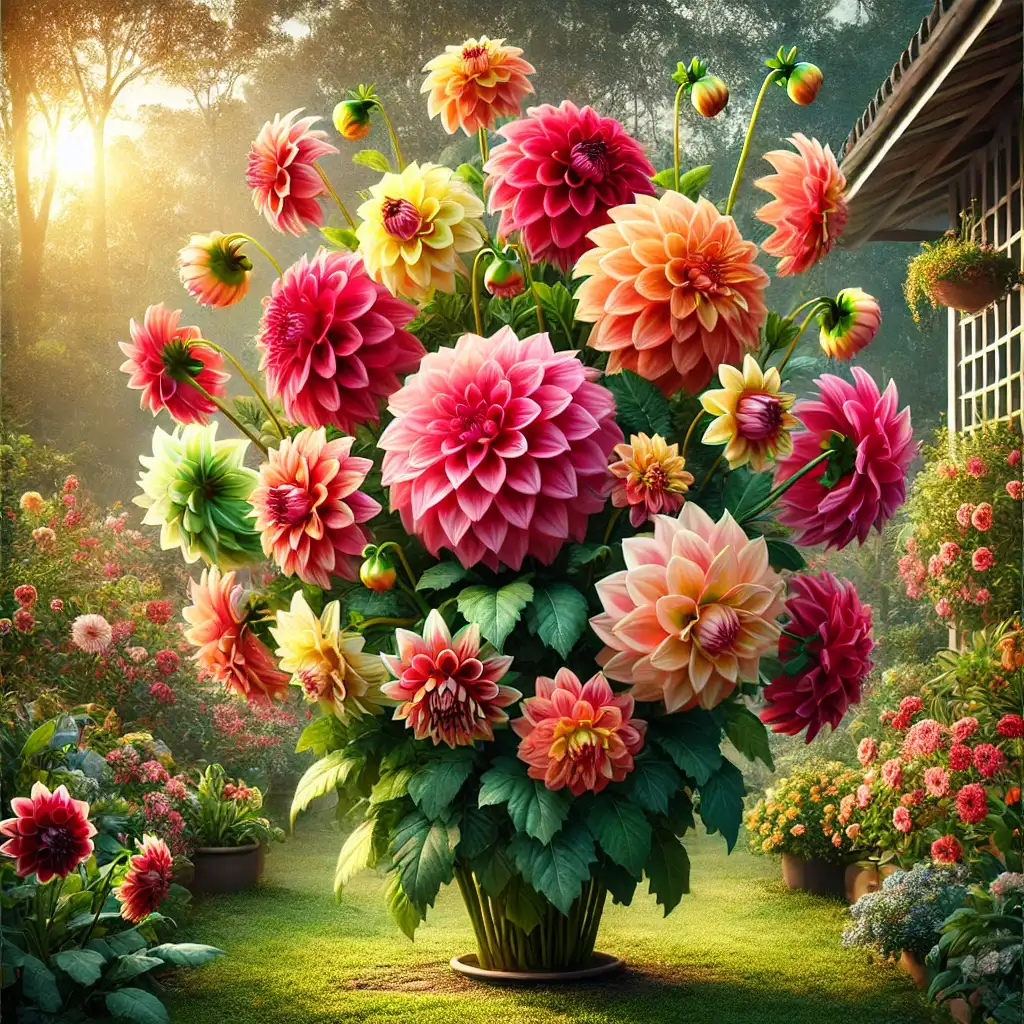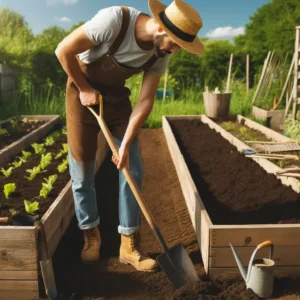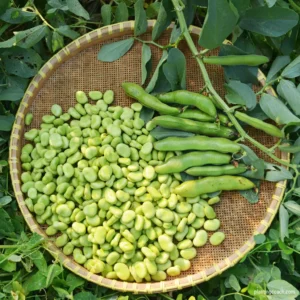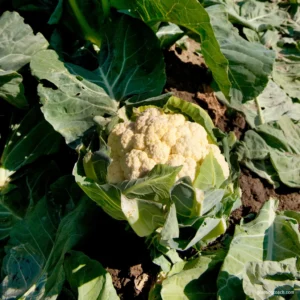Dahlias are beloved by gardeners for their vibrant colours and diverse flower shapes, making them a standout addition to any garden. Originating from Central America, these stunning blooms have become a favourite worldwide due to their ability to thrive in various climates and conditions. Growing dahlias can be a rewarding experience, but it requires some knowledge and effort to ensure they flourish. This guide will walk you through everything you need to know about How to Grow Dahlias, from selecting the right types to planting, caring, and propagating them successfully.
Understanding Dahlias
Dahlias are a genus of bushy, tuberous, herbaceous perennial plants native to Mexico. They belong to the Asteraceae family, which includes sunflowers, daisies, and chrysanthemums. Dahlias come in various colours, sizes, and forms, from small, single-petaled flowers to large, dinner-plate-sized blooms. This diversity makes them a versatile choice for various garden styles and settings.

Today, there are over 42 species and countless hybrids, offering an extensive palette for gardeners to choose from. Understanding the basic needs of dahlias is crucial for successful cultivation. They thrive in well-drained soil rich in organic matter and require full sun to produce the best blooms. While they can tolerate a range of soil types, they prefer slightly acidic to neutral pH levels. Regular watering and feeding are essential, as dahlias are heavy feeders and require consistent moisture to develop strong roots and vibrant flowers.
Types of Dahlia to Grow
When selecting dahlias for your garden, it’s essential to consider the various types available. Dahlias are classified into several categories based on their flower form, including decorative, cactus, ball, pompon, anemone, and more. Each type has unique characteristics, making them suitable for different aesthetic preferences and garden conditions.
Decorative dahlias are among the most popular, known for their large, fully double blooms with broad, flat petals. These are ideal for creating a bold, dramatic statement in your garden.
Cactus dahlias, on the other hand, have narrow, pointed petals that give them a spiky appearance, adding texture and interest to your floral displays.

Ball and pompon dahlias are characterized by their perfectly rounded blooms, with tightly packed petals forming a globe-like shape. These types are excellent for adding structure and uniformity to your garden beds.
Anemone dahlias feature a central disc surrounded by one or more rings of petals, resembling an anemone flower, which can add a whimsical touch to your garden.
Consider factors such as bloom size, colour, and height when choosing dahlia types. Taller varieties may require staking to support their heavy blooms, while shorter varieties are perfect for borders and containers. By selecting a mix of dahlia types, you can create a diverse and visually appealing garden that showcases the full range of these stunning flowers.
Where and When to Plant Dahlias
Choosing the right location and timing for planting dahlias is crucial for their success.
Best location to plant dahlias: Dahlias thrive in sunny locations, requiring at least six to eight hours of direct sunlight daily. A well-drained soil is essential, as waterlogged conditions can cause the tubers to rot. Before planting, prepare the soil by incorporating organic matter, such as compost or well-rotted manure, to improve fertility and drainage.

Planting time for dahlias: The best time to plant dahlias depends on your local climate. Generally, they are planted in the spring after the last frost date when the soil has warmed up. In colder regions, you may need to start the tubers indoors in pots about 4-6 weeks before the last frost. Once the danger of frost has passed, you can transplant them into the garden.
In addition, In warmer climates, where frost is less of a concern, dahlias can be planted directly into the garden in early spring. Ensure the soil temperature is at least 60°F (15°C) to encourage proper root development. Space the tubers about 18 to 24 inches apart, depending on the variety, to allow adequate air circulation and room for growth.
How to Plant Dahlia Tubers
Planting dahlia tubers correctly is vital for ensuring robust growth and abundant blooms. Start by selecting healthy tubers with at least one eye or bud, which is where the new growth will emerge. Avoid tubers that are shrivelled or show signs of mould.
Digging: To plant dahlia tubers, dig a hole about 6 to 8 inches deep and wide enough to accommodate the tuber comfortably. Place the tuber horizontally with the eye facing upward. Cover the tuber with about 2 to 3 inches of soil, leaving a slight depression around the planting area to help with watering. As the plant grows, gradually fill in the hole with soil.
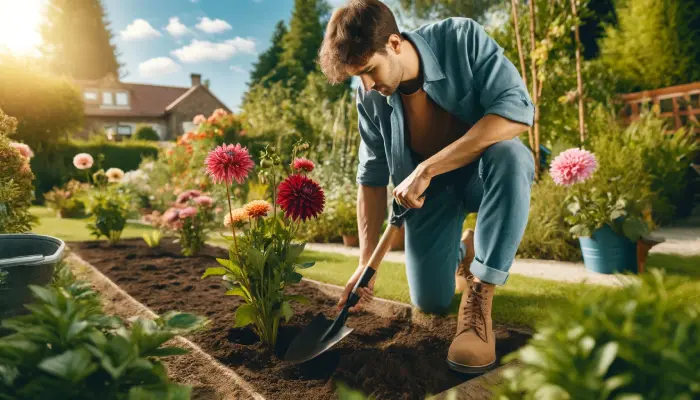
Spacing: If you are planting multiple dahlias, space the holes 18 to 24 inches apart to ensure each plant has enough room to develop. Consider installing stakes or supports when planting taller varieties to avoid damaging the tubers later. This will help keep the plants upright as they grow and prevent the stems from breaking under the weight of the blooms.
Watering: Thoroughly water the newly planted tubers to settle the soil around them. During the initial growth phase, keep the soil consistently moist but not waterlogged. Once the plants are established and growing, you can reduce the watering frequency, ensuring they receive about an inch of water per week, either from rainfall or supplemental irrigation.
Feeding: Fertilize dahlias with a balanced, low-nitrogen fertilizer to promote strong root development and abundant flowering. Avoid high-nitrogen fertilizers, as they can encourage excessive foliage growth at the expense of blooms.
How to Grow Dahlias in Containers
Growing dahlias in containers is an excellent option for those with limited garden space or who want to add colour to patios, balconies, or terraces. The key to success with container-grown dahlias lies in selecting the right container, soil, and care regimen.
Right container with proper soil mix: Choose a container that is at least 12 inches in diameter and depth to accommodate the tuber and provide sufficient room for root growth. Containers with drainage holes are essential to prevent waterlogging, which can lead to root rot. Fill the container with a high-quality potting mix that is well-draining and rich in organic matter. Avoid using garden soil, as it can become compacted and hinder root development.

Planting tuber: Plant the dahlia tuber in the container following the same guidelines as for garden planting. Place the tuber horizontally with the eye facing up, cover it with 2 to 3 inches of soil, and water thoroughly. As the plant grows, add more soil to cover the tuber completely.
Maintaining a proper watering schedule: Container-grown dahlias require regular watering, as containers dry out more quickly than garden soil. Water deeply until excess water drains from the bottom, ensuring the entire root system is moist. During hot weather, you may need to water daily to moisten the soil.
Fertilizing Schedule: To provide essential nutrients, fertilize container dahlias with a balanced, water-soluble fertilizer every two to four weeks. Regular feeding supports healthy growth and prolific blooming. Deadhead spent flowers to encourage continuous flowering and remove yellowing leaves to maintain plant health.
How to Care for Dahlias
Caring for dahlias involves regular watering, feeding, and maintenance to ensure they thrive and produce abundant blooms.
Watering: Dahlias need consistent moisture, particularly during dry spells. Water deeply once or twice a week, ensuring the soil remains moist but not waterlogged. Mulching around the plants can help retain moisture and keep the roots cool.
Feeding: Dahlias are heavy feeders, so feeding them is crucial. Apply a balanced, low-nitrogen fertilizer every three to four weeks throughout the growing season. An N-P-K ratio of 5-10-10 or 10-20-20 is ideal, as it encourages strong root development and prolific blooming. Avoid high-nitrogen fertilizers, which promote foliage growth at the expense of flowers.
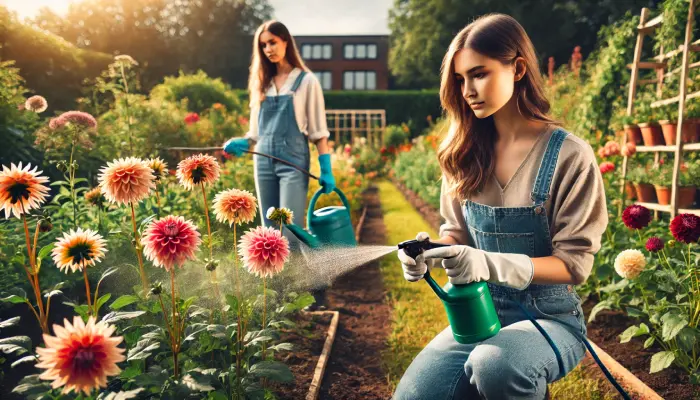
Pruning: Pruning and deadheading are essential for maintaining healthy dahlia plants and encouraging continuous blooming. Remove spent flowers regularly to prevent the plant from setting seed and promote new bud growth. Pinching back the growing tips when the plant reaches about 12-18 inches tall can encourage bushier growth and more blooms.
Staking: Taller varieties must be staked to support the heavy blooms and prevent the stems from breaking. Use stakes or plant supports and tie the stems loosely with garden twine as the plant grows. Regularly check the ties and adjust them as needed to avoid damaging the stems.
Applying pesticides: Pest and disease management is also vital. Watch for common pests such as aphids, spider mites, and slugs, and treat infestations promptly with appropriate insecticides or organic methods like neem oil or insecticidal soap. Keep an eye out for signs of disease, such as powdery mildew or root rot, and take preventive measures like proper spacing and watering practices to maintain healthy plants.
Dahlia Propagating Tips
Propagating dahlias can be done through several methods, including dividing tubers, taking cuttings, and growing from seed. Each method has its advantages and can be used to expand your dahlia collection or share with other gardeners.
Dividing tubers is the most common method of propagation. In the fall, after the first frost has blackened the foliage, carefully dig up the tubers and gently clean off the soil. Allow the tubers to dry in a cool, dry place for a few days. Once dry, divide the clump into individual tubers, ensuring each division has at least one eye. Store the divided tubers in a cool, frost-free location until spring, when they can be planted.
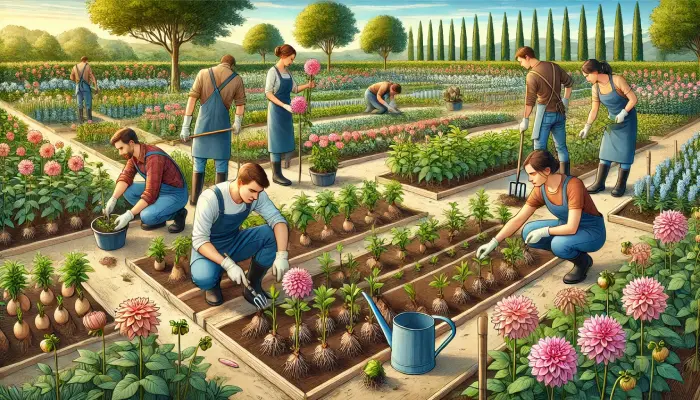
Taking cuttings is another effective way to propagate dahlias. In early spring, when the tubers start to sprout, cut a 3-4 inch section of the new shoot just below a leaf node. Remove the lower leaves and dip the cut end in the rooting hormone. Plant the cutting in a pot filled with a well-draining potting mix and keep it moist and warm. In a few weeks, roots will develop, and the new plant can be transplanted into the garden.
Growing dahlias from seed is less common but can be rewarding, especially for creating new hybrids. Sow dahlia seeds indoors 6-8 weeks before the last frost date. Plant the seeds in seed trays filled with a seed-starting mix, cover lightly with soil, and keep moist. Once the seedlings have developed several true leaves, transplant them into individual pots. Harden off the young plants before transplanting them into the garden after the danger of frost has passed.
Common Problems While Growing Dahlias
While dahlias are relatively easy to grow, they can encounter several common problems that may hinder their growth and flowering. Being aware of these issues and knowing how to address them can help you maintain healthy plants and enjoy rewarding blooms.
Pests: One common issue is pests such as aphids, spider mites, and slugs. Aphids can be controlled by spraying the plants with a strong stream of water or using insecticidal soap. Spider mites, which thrive in hot and dry conditions, can be managed by keeping the plants well-watered and occasionally spraying the foliage with water. Slugs and snails can be controlled by using slug pellets, beer traps, or manually removing them from the plants.

Diseases: Diseases such as powdery mildew, botrytis blight, and root rot can also affect dahlias. Powdery mildew appears as a white, powdery coating on the leaves and can be prevented by ensuring good air circulation and avoiding overhead watering. Botrytis blight, which causes gray mold on the flowers and leaves, can be minimized by removing affected plant parts and improving air circulation. Root rot, often caused by overwatering or poorly draining soil, can be prevented by planting dahlias in well-drained soil and avoiding excessive watering.
Poor blooming: Another common problem is poor blooming, which can be due to several factors such as inadequate sunlight, excessive nitrogen, or improper pinching. Ensure your dahlias receive at least six hours of direct sunlight daily, use a balanced fertilizer, and pinch back the growing tips to encourage more blooms.
By staying vigilant and addressing these common problems promptly, you can ensure your dahlias remain healthy and produce a stunning display of flowers throughout the growing season.
Summary
Among all the rewarding experiences a gardener can enjoy, growing dahlias is one of the most satisfying ones. They add vibrant color and striking blooms to a garden. You can enjoy a plentiful display of these stunning flowers by understanding the different types of dahlias, knowing when and where to plant them, and following proper planting and care techniques. From planting tubers in the garden or containers to caring for them through regular watering, feeding, and maintenance, each step is crucial for ensuring healthy growth and prolific blooming. Furthermore, being aware of common problems, such as pests and diseases, and knowing how to address them will help you maintain healthy plants and enjoy continuous blooms throughout the season.
FAQ
Q1: How long do dahlias take to grow?
A1: Dahlias typically take about 8 to 10 weeks from planting to first bloom. This timeline can vary depending on the variety and growing conditions, but you can generally expect to see flowers within this period after planting the tubers or seedlings.
Q2: Can dahlias be grown indoors?
A2: While dahlias are typically grown outdoors, they can be started indoors in pots if you live in a region with a short growing season. Start the tubers indoors in early spring and transplant them outside after the last frost date. However, they do require plenty of sunlight, so ensure they are placed in a bright location.
Q3: How often should I water my dahlias?
A3: Dahlias need consistent moisture, especially during dry periods. Water them deeply once or twice a week, ensuring the soil remains moist but not waterlogged. Container-grown dahlias may require more frequent watering, sometimes daily during hot weather, to keep the soil consistently moist.
Q4: Why are my dahlias not blooming?
A4: Several factors can cause dahlias to fail to bloom, including inadequate sunlight, excessive nitrogen in the soil, or improper pinching. To encourage more blooms, ensure your dahlias receive at least six hours of direct sunlight daily, use a balanced fertilizer, and pinch back the growing tips.
Q5: Can I leave Dahlia tubers in the ground over winter?
A5: In regions with mild winters (zones 8-10), dahlia tubers can be left in the ground if the soil is well-drained and protected with a thick layer of mulch. In colder regions, it’s advisable to dig up the tubers after the first frost, store them in a cool, dry place, and replant them in the spring to prevent frost damage.
